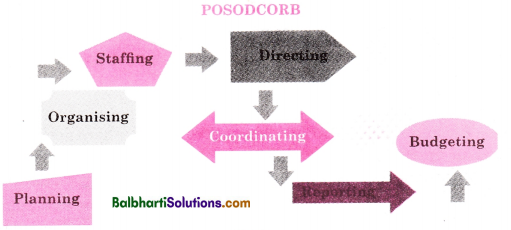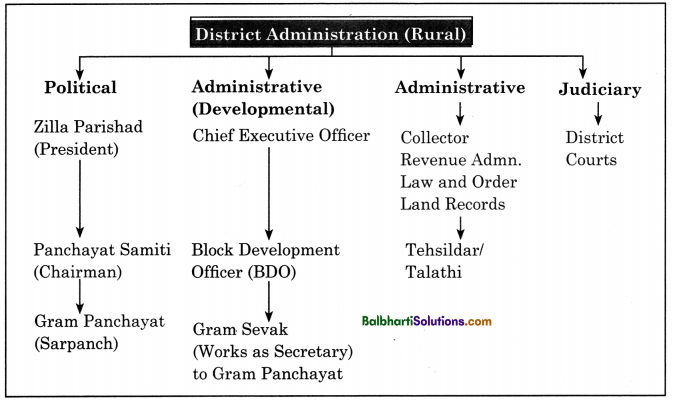By going through these Maharashtra State Board Class 11 Political Science Notes Chapter 7 Public Administration students can recall all the concepts quickly.
Maharashtra State Board Class 11 Political Science Notes Chapter 7 Public Administration
Introduction
In this chapter, we will deal with the meaning, scope and evolution of Public Administration. We will also study about the administrative system in India. Public administration implements policy. The administration of national, state and local government institutions is called public administration.
There are two aspects to public administration.
1. One is a general aspect. It focuses on the following:
- Planning the outline of things to be done.
- Creating a structure of organisation to implement the decisions.
- Appointing people to do the work.
- Coordinating the work to ensure that it is done properly.
- Provide the finance to do the activity.
2. The second is a specialised aspect. There are many specialised functions like maintaining law and order, providing education, ensuring public health, promoting agriculture, providing social security, etc. Each of these is a specialised activity requiring special skills for example, public health requires doctors, law and order requires police.
When the administration of these activities is carried out by the government, it is called public administration. Public Administration as a discipline was born in the United States. Woodrow Wilson was the first to emphasise the need for the study of public administration as a subject.
![]()
Public Administration
Meaning : Public Administration is a sub-discipline of Political Science. It focuses on ‘government in action’ i.e., implementation of government decisions, policies and programmes in the fields of social security and welfare, law and order, transport and communication, health and sanitation, etc.
The executive branch of government consists of the Political Executive (Council of Ministers) and Permanent or Non-political Executive or Bureaucracy.
Public Administration as a subject studies the activity and process of the government.
According to Dwight Waldo, ‘Public administration is the art and science of management as applied to the affairs of the State’.
Public Administration broadly includes the following –
- Activities of all three branches of government, especially that of the executive branch.
- Non-political public bureaucracy operating in a political system.
- Management of public affairs and policy execution.
- Concerned with public welfare and hence provides service and regulatory functions to the people to attain a good life.
Scope Of Public Administration
The scope of Public Administration can be studied as two categories.
(A) Narrow Perspective – It focuses on aspects related only with the executive branch of government. Gullick and Urwick sum up this view in the acronym POSDCORB to denote Planning, Organisation, Staffing, Directing, Coordinating. Reporting and Budgeting.

- Planning – Working out in broad outline or a blueprint of what is to be done and methods to be adopted for it e.g., NITI Aayog has adopted the approach of grassroots to national level for development.
- Organisation – Establishing the formal structure of authority through which work is delegated, defined and coordinated e.g., All India Services like IAS, I.P.S., etc.
- Staffing – Recruitment, training and working conditions of personnel e.g., in India this is through Union Public Service Commission (UPSC).
- Directing: Making decisions and issuing instructions and orders as administration is a continuous
activity. - Coordinating – Interrelating the work of various sections and parts of the organisation to eliminate overlapping of work or conflict over responsibility.
- Reporting – Reporting to superiors and higher authorities any information about on-going and /or completed tasks. This ensures responsibility and accountability.
- Budgeting – Refers to fiscal planning, control and accounting.
![]()
(B) Broad Perspective – This differs from the narrow, managerial view of public administration. It includes activities of all three branches of the government, their interrelationships; specialized government functions such as defence, finance, health care, etc., as well as collaborations with private groups e.g., NGO’s in providing services to the community. This view is concerned with techniques of administration (POSDCORB) as well as with substantive matters of administration.
According to Woodrow Wilson, ‘Administration is the most obvious part of the government — it is government in action, the most visible, operative side of the government.’
Evolution Of Public Administration
Since ancient times, various thinkers have contributed to administrative thought and practice for e.g., Kautilya’s — ‘Arthashastra’(a text on administration and political economy), Aristotle’s ‘Politics’ (in ancient Greece) and Machiavelli’s ‘The Prince’ (in medieval Italy)
In the 18th century, Cameralism in Germany and Austria was concerned with the systematic management of governmental affairs. It stressed on descriptive studies of the structure and procedures of public administration as well as professional training of public officials. George Zincke was the most distinguished scholar of this group.
Public administration as a separate subject of study originated in the USA mainly due to factors like.
- Large scale organisations which arose due to industrialization.
- Scientific Management Movement by Taylor.
- Emergence of Welfare State where the government had to perform a variety of functions.
Woodrow Wilson’s celebrated essay ‘The Study of Administration’ (1887) laid the foundation for the systematic, separate study of public administration. He is regarded as ‘The Father of Public Administration’. He advocated politics – administration dichotomy i.e., separation of administration from politics. According to him politics is concerned with policy making while administration in concerned with implementation of policy decisions Wilson emphasized the need to increase government efficiency.
Today, the subject matter of public administration has expanded to include areas like comparitive studies, public policy, new public management and good governance.
Public Policy
Public policy refers to the new approach to understand aspects of government activities for public welfare that is beyond simple administrative activities e.g., Ayushman Bharat which aims to provide universal access to good quality health care in India.
Public policy can be understood in three steps.
- Policy Choice – Elected representatives, bureaucrats and others decide on which concerns of citizens to deal with. Various options available about how to deal with it and the formulation of a programme is also decided e.g., anti-malaria programme (its objectives and implementation).
- Policy Output – Actual implementation of the policy takes place and policy output is determined.
- Policy Impact (evaluation stage) – This involves assessment of the objectives to determine policy impact and any improvements if required.
![]()
Administrative System In India
The Indian Administrative System is a legacy of the British rule in terms of structural and functional aspects like centrally controlled administrative system, police and revenue administration, training procedures, etc. However, even before this, India had many instances of good administrative systems such as during the reign of Chandragupta Maurya, of Emperor Akbar and of Chhatrapati Shivaji Maharaj. The British implemented administrative measures through various acts like Indian Councils Act 1909, Government of India Acts (1919, 1935), Indian Police Act (1861) Local Self Government set up by Lord Ripon, establishment of Reserve Bank (1935), etc.
After Independence, the administrative system in India has been guided by constitutional ideals such ars Liberty, Justice and Equality.
The broad framework of the administrative system in India includes –
- Three level administrative structures i.e., at the National level, State level, Local level.
- Three branches of government i.e., Legislature, Executive, Judiciary.
At the National level: Work of the Central (Union) government is done by various ministries, headed by a Minister, below which is the administrative machinery e.g., Departments of Home, Finance, Defence, Health, etc. There are also institutions like NITI Aayog, U.P.S.C., N.H.R.C, Election Commission, etc., which require administrative staff.
At the State level : Here also, there are various ministries, commissions, institutions to carry out government work. So administrative staff is involved here too.
At the local level: This may be urban or rural types of administration.


![]()
Recruitment for all posts, at all levels is through competitive exams, conducted by various government bodies e.g., U.P.S.C. and Staff Selection Commission (at union level) public service commission in states e.g., M.P.S.C. All bureaucrats owe allegiance to the constitution and not to any political party. This is the principle of political neutrality.